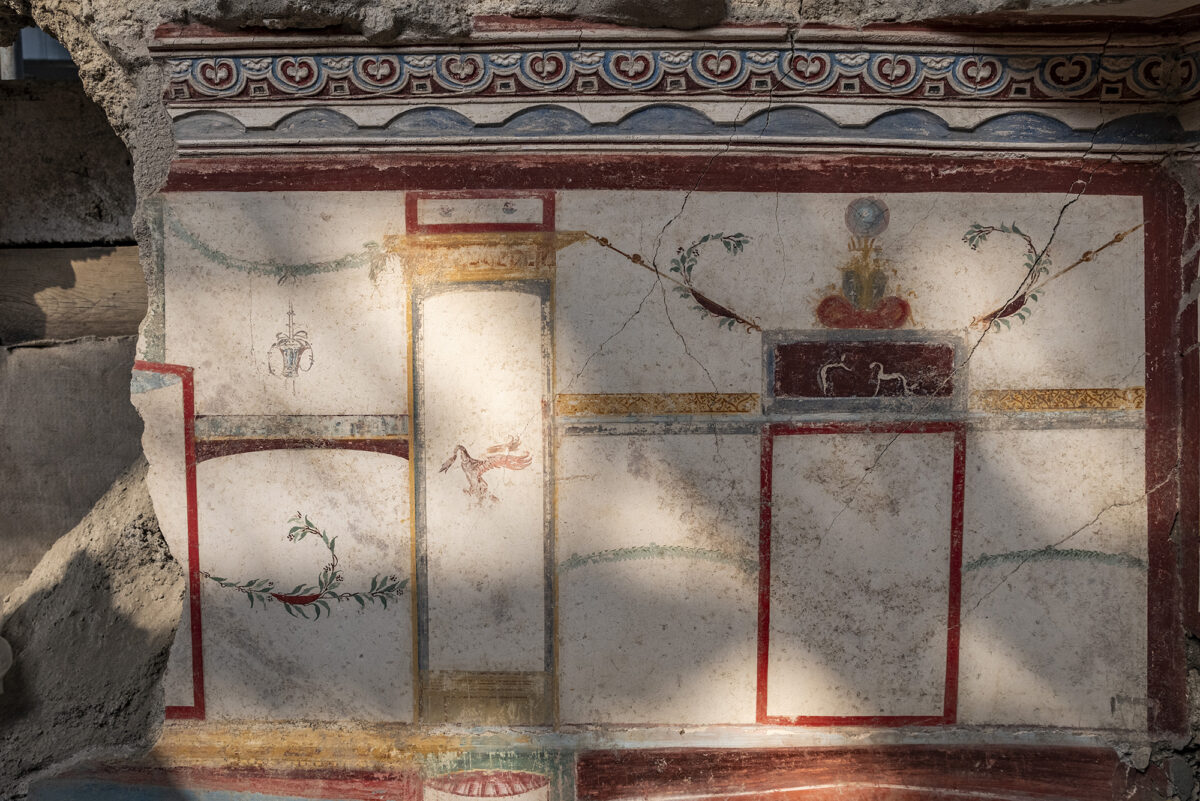A decorated ‘Tiny House’ has been discovered in Pompeii

The British would call them “tiny houses”: small, detached dwellings but, in this case, with extremely elegant decoration. This is the case for one of the most recent houses to have been discovered during the excavations currently underway in the Insula of the Casa dei Casti Amanti, in the central district of the ancient city of Pompeii along Via dell’Abbondanza.
The house is small and lacks the traditional atrium. This was rather peculiar because, despite the limited scale of the residence, it would not have been impossible to add a small atrium with the classic pool to catch rainwater (impluvium), typical of the architecture of the richer Pompeian houses. However, in this case, it is conspicuous by its absence.
The choice was probably related to the changes that were affecting Roman society, and Pompeian society in particular, during the first century AD and which can now be studied and investigated thanks to this discovery.
The striking feature of the house is the exceptional quality of the wall paintings, which is in no way inferior to the larger, sumptuous house known as the Casa dei Pittori al Lavoro which adjoins it. Due to the discovery of a well-preserved fresco depicting the myth of Hyppolytus and Phaedra, it was given the provisional name of Casa di Fedra.
The two rooms currently under investigation are situated at the back of the house. In the first one, besides the mythological painting of Hyppolytus and Phaedra, the splendidly decorated Fourth Style walls illustrate other scenes taken from the repertoire of classical myths: a depiction of a symplegma scene (coupling) between a satyr and a nymph, a small painting showing a divine couple, possibly Venus and Adonis, as well as a scene, unfortunately damaged by Bourbon explorations, which may be interpreted as The Judgement of Paris.
A window beside the small painting of Hyppolytus and Phaedra looks onto a small courtyard where building work was being carried out at the moment of the eruption. The entrance to the courtyard is marked by the presence of a small lararium (household shrine) with elaborate painted decoration with plant and animal motifs on a white background.
The courtyard has a roofed area that precedes a large pool with red-painted walls. A channel ran round the pool, enabling rainwater to be conveyed towards the mouth of a well linked to the cistern below.
A bird of prey stands out in the upper part of the lararium. The raptor, which can probably be identified as an eagle, holds a palm branch in its claws. In the lower part, the scene consists of two snakes facing each other which frame an altar with a fluted circular shaft on which offerings are placed. From the left, it is possible to distinguish the following features: a pine cone, a raised element that supports an egg, and what appear to be a fig and a date. The background of the scene is filled with two bushes with lanceolate leaves and red and yellow berries on which three sparrows move about.
Several interesting finds were discovered inside the niche: ritual objects, left as part of a last offering before the eruption that destroyed Pompeii in AD 79: an incense burner in achromatic clay with missing pieces dating from antiquity and a lamp, both displaying clear signs of burning. Laboratory analyses have made it possible to identify the remains of twigs of aromatic plants, while two parts of a dried fig were found behind the two objects. Two strips of coloured marble were discovered on the flat top of the altar together with a third element, presumably made of red marble, with the depiction of a face ascribable to the Dionysian world, probably a Silenus.
Lastly, a quadrangular, moulded marble base with a central slot was found in the front part of the altar while an iron knife was discovered on the left side. The knife handle terminates in a circular hook so that it could be hung up.

The excavations currently underway in the Insula of the Casa dei Casti Amanti represent part of a complex project – divided into two separate parts – being conducted in various phases, some of which have already finished and enable visitors to gain access to the complex through a system of elevated walkways. The phases were marked by the following: the testing, design and construction of a new roof; archaeological excavations; the re-profiling of the excavation faces; the consolidation of the walls to make them safe; the restoration of archaeological surfaces and elements.
The Park archaeologists are currently working in the north-east sector of the Insula, inside a series of rooms with access from the east lane. The excavations are helping to shed increasing light on the plan of the insula so that this new house can now be clearly identified.
“This is an example of public archaeology or, as I prefer to term it, circular archaeology: preservation, research, management, accessibility and use create a virtuous circle,” stated Gabriel Zuchtriegel, the Park Director. “Carrying out excavations and restoration work in full view of visitors but also publishing the data online in our e-journal and on the platform open.pompeiisites.org means giving back full transparency to society, which funds our activities through tickets, taxes and sponsorship, in terms of what we do, which is not just for the benefit of a small circle of scholars but for everyone. Archaeology must belong to society as a whole because only in this way can we promote understanding of how archaeologists work throughout Italy on excavations as part of what is termed ‘preventive archaeology’. If building work on an underground railway or a road is delayed due to archaeological discoveries, visiting Pompeii and observing the work of archaeologists and restorers can help us appreciate why it is worth recording and safeguarding the traces of the generations who preceded us.”
